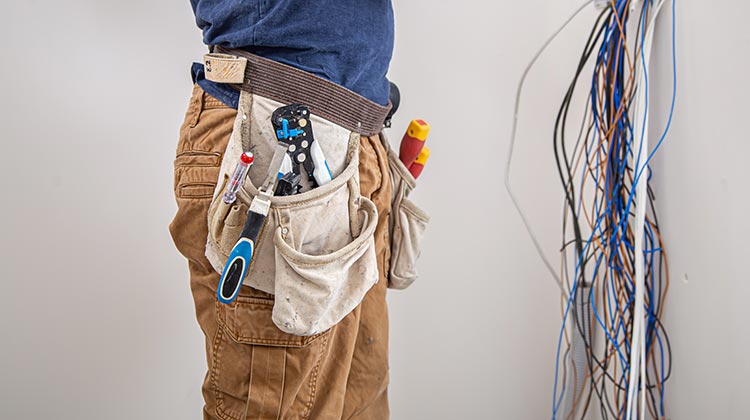
Electricians are specialists that pack a variety of unique tools to help them safely and efficiently inspect, fix and install electrical components or systems. Here are six crucial tools that every electrician should have in their toolbox.
Voltage Tester
Voltage testers are key tools for electricians conducting inspection and testing tasks. Voltage testers can be placed near a component in order to ascertain whether there is a live current passing through it. Most voltage testers indicate the presence of a live current with a Light Emitting Diode. Professional electricians use testers with redundant circuits to protect them against any surge in current. Before dismantling any electrical component, an electrician usually double-checks that it is safe to proceed using their voltage tester – even if the component has been manually isolated using a switch.
Modern voltage testers can be used without directly contacting a component. They sense the very small electrical current that is capacitively transmitted to sources approaching active electrical componentry. Non-contact voltage testers cannot be used through a metal shield or conduit. A voltage tester is usually the first item that an electrician pulls out of their bag when assessing a task.
Multimeter
Much like a voltage tester, a multimeter is an essential tool for testing and inspection. Multimeters – also known as volt ohm milliammeters – are designed to measure current, voltage, and resistance. Unlike voltage testers, they often display a reading – allowing an electrician to diagnose problems with electrical circuitry. In recent years, digital multimeters have become more popular amongst electricians than their analogue counterparts. Digital multimeters are more reliable and give more detailed readings than analogue testing devices.
Multimeters are absolutely essential tools that can be used to ensure operator safety and diagnose all sorts of electrical issues. Check out this guide to multimeter use published by Spark Fun for more information.
Additional Resource
Wire Stripper
Wire strippers are pretty self-explanatory tools. Most electrical wiring is insulated so it can be safely handled and efficiently transmit current. In order to expose the conductive wiring underneath the insulating rubber, wire strippers need to be used. These delicate plier-like tools allow an electrician to strip off rubber insulating layers without damaging the conducting wire underneath. Wire strippers come in all shapes and sizes in correlation to the many varieties of wire and insulation that are on the market and in our homes.
Insulated Screwdrivers
The screwdriver is the most basic of tools, but that doesn’t mean it isn’t a crucial part of any electrician’s arsenal. It is absolutely essential that screwdrivers are correctly insulated if they are going to be used for inspecting and disassembling electrical circuits. Even when components are isolated, they can still sometimes hold a charge. Electricians risk being subjected to a nasty shock if they use non-insulated tools. A great deal of work with a screwdriver is usually needed before the bowels of an electrical system can be accessed. Some systems require specialist screwdrivers such as hex heads in order to be opened up. This is to prevent consumers from endangering themselves by opening up volatile systems.
Properly insulated screwdrivers will have a VDE symbol printed on them to indicate that their safety level has been approved by the European safety inspectorate group Verband Der Elektrotechnik.
Electrical Tape
Any electrician worth their salt will have a roll of electrical tape or two in their toolkit. Electrical tape is essentially just masking tape made of an extremely insulating material. It can be used to temporarily make connections safe to work with or even to permanently seal an open conducting connection. Electrical tape should not be used in instances where a connection will be exposed to water as it will not provide a watertight seal. Electrical tape is often colour-coded. Different tape patterns indicate different kinds of wiring or connection. In the UK, green and yellow tape often indicates that the wire it is applied to is a protective earthing wire. Blue tape is used to mark low voltage neutral wires, and red tape marks low voltage Alternating Current wires.
Head Torch
As part of their work, electricians need to access dark and confined spaces. They need to maintain their ability to work safely and precisely within these spaces. Conventional handheld torches are not appropriate for electrical work, as both hands are usually needed to complete a task. Instead, LED head-mounted torches are the working standard for professionals. Light Emitting Diodes are much more efficient than conventional filament bulbs and therefore make perfect light-producing elements for head-mounted torches.

Leave a Reply